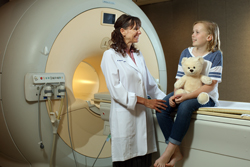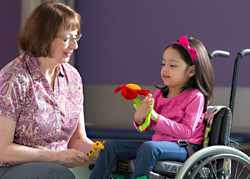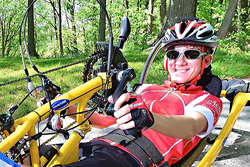Clinical research at the Center is a reflection of the care that we provide to our patients.
Through our research, we hope to develop new improvements to the services we offer and discover new ways to help you reach your greatest potential.
Epidural Implants Help Patients Walk Again: What Does It Mean for You?
You might have seen some recent news stories about patients with spinal cord injuries recovering their ability to walk after receiving epidural implants and participating in intensive physical therapy.
Epidural implants provide stimulation directly to the spinal cord. The stimulation provided by the implants increases the excitability of the spinal cord. In nearly all cases of spinal cord injury, there are axons that span the lesion. In patients with complete spinal cord injuries, however, these axons don’t carry enough signal from the brain to generate movement. The stimulation provided by epidural implants augments the signal, allowing for the possibility of movement. Essentially, the stimulator turns up the volume on the remaining connections, but patients still have to undergo intensive physical therapy to relearn how to walk.
Patients with epidural implants do not fully recover their pre-injury walking abilities, but the implants do give them more mobility and incremental improvements in their quality of life. The hope is that standing and stepping will improve circulation, bone density and cardiovascular health, and could lead to more neurological changes over the long term. This is the first time anyone has demonstrated the recovery of walking in a patient with a complete injury. These findings are very exciting for the community, but there is evidence to suggest you may be able to get the same benefits without having to undergo the surgery and implant.
At the International Center for Spinal Cord Injury at Kennedy Krieger Institute, we have been studying transcutaneous spinal cord stimulation (TSCS). This stimulation is applied to the spinal cord across the surface of the skin, like the peripheral nerve stimulation (PNS) you are used to receiving in therapy here. Traditional PNS is used to produce a specific movement for a specific task (e.g., lifting your toes during walking). Like the epidural implant, TSCS is intended to increase the excitability of the spinal cord, augmenting the signals of neural circuits. This is a much less specific kind of stimulation, but it may result in more global changes in function. It may allow you to not only lift your toes, but also—and at the same time—bend your knees and hips as well.
Patients in our current study receive TSCS in combination with intensive walking-based therapy and are showing improvements in walking speed, endurance and quality of life. Patients are also reporting changes in bowel and bladder function and sensation. There is still a lot of work to be done to understand how TSCS works, how much of it is needed to change walking function, and the best stimulation parameters for different types of patients, but it is a promising intervention.
Always eager to push for more, the therapists at the spinal cord injury center have begun to incorporate TSCS into clinical treatment while the research is ongoing. Therapists may add TSCS to any of our regular interventions, with the hope of augmenting their effects. It is essential for patients to be intentional about their movement during therapy to see effects on function.
Good candidates for TSCS are in good physical condition and have maintained muscle bulk and length through regular exercise and stretching. Because the stimulation is applied through the abdomen, patients with a low waist circumference-to-height ratio may respond better to TSCS. If you’re interested in trialing TSCS as part of your ongoing therapy, talk with your therapist, or contact the spinal cord injury center at 888-923-9222.
Activity-Based Restorative Therapy (and Electrical Stimulation)
Electrical stimulation is a key component of our activity-based restorative therapy program. Electrodes are placed on specific muscle groups by a skilled therapist. Those electrodes are connected to a machine that sends an electrical signal, which cause muscles to contract. Electrical stimulation is used to practice specific tasks, increase or maintain range of motion, and prevent muscle loss. Our research in this area has focused on studying the impact, effectiveness, and optimal protocols for functional electrical stimulation (FES) and activity-based restorative therapy, as well as transcutaneous spinal cord stimulation and its impact on physical and neurological function.

Aquatic Therapy
Aquatic therapy is a popular program at the Center and we have seen firsthand the potential benefits of aquatic therapy for our patients. In the pool, you are able to escape the limitations of gravity and can perform tasks that are difficult or impossible over land. By practicing these tasks in the water, we hope to improve your strength and eventually help you to accomplish performing these tasks on land. Aquatic therapy research focuses on studying and quantifying the impact of aquatic therapy on functional and health-related quality of life outcomes among individuals with paralysis and comparing this to land therapy outcomes.

Advanced Imaging
Everyone who has experienced paralysis has undergone an MRI (magnetic resonance imaging) at least once. At the center we study an advanced imaging process called functional MRI (fMRI) that can produce maps of neuronal activity at most levels of the spinal cord in response to various stimuli (i.e. touch, vibration, temperature changes, etc.) and with motor tasks. These images can help us to study how these circuits of neuronal activity change after traumatic spinal cord injury and after implementation of an activity-based therapy program, in order to understand how different treatment options can be best utilized to maximize patient recovery.

Complications of Spinal Cord Injury and Paralysis
Spinal cord injury and paralysis are widely known to cause what are called “secondary complications,” such as pressure sores, urological conditions, spasticity, pain, and osteoporosis. These are common complaints for many people with spinal cord injury or dysfunction. We believe that it is important to study the prevalence of these common complications, their individual causes and risk factors, their impact on community engagement and quality of life, and prevention of these complications.

Adaptive Sports
The center believes that adaptive sports and recreation can be integral to recovery and quality-of-life. For many of you, sports and recreation were a regular part of your lives prior to injury or diagnosis and we believe that everyone should have the same opportunities even after a disability. Our researchers are studying the use of virtual reality adaptive sporting as a training method and the impact of adaptive sporting on both rehabilitation outcomes and overall quality of life.
